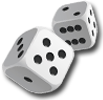



play board games
Board game reviews, strategy tips & session reports
Glory to Rome Review
 Stats:
Stats:
No. of players: 2-5
Amount of time to play: 60 min
Age requirements: 12+
Set-up time: 5 minutes
Glory to Rome is a role-selection card game. You must aid Caesar in the rebuilding of Rome. Can you score more victory points and win the game?
Glory to Rome Rules Description:
The first thing to know about Glory to Rome is that each card can be used in variety of ways. Cards may be used for their Role, Material, Structure or Money. What a card is used for is usually determined by when it is played or where it is in the playing area. The playing area consists of your Clientele, Stockpile, Vault, Influence and a shared Pool.
On your turn you choose a Role. Every other player may then follow by playing a matching Role card or a Jack (which acts as a wildcard). If you follow you may take the Role the first player selected. If you do not wish to (or are unable to) follow you may think. Thinking allows you to draw back up to five cards, draw an additional card if you are already have five or take one Jack. Roles you have in your Clientele may always follow even when you Think.
The six Roles are Laborer, Legionary, Patron, Craftsman, Architect and Merchant. Laborer lets you take a Material from the Pool. Legionary lets you take Materials from the Pool and your opponents’ hands into your Stockpile. Patron lets you take a card from the Pool and add it to your Clientele. Craftsman lets you place a card you want to build from your hand or add a card to a Building. Architect does the same thing but takes the card from your Stockpile. Merchant puts a card from your Stockpile into your Vault.
When you start a Building, whether using the Architect or Craftsman, you take a Site card that matches the Material of that Building. Then you add cards to finish that Building. The number of cards you’ll need to add depends on the Material of the Building. Once finished, Buildings give you additional abilities. The Site card from the finished Building also adds to your Influence.
The number of cards in your Vault and your number of Clientele are limited by your total Influence.
The game ends when the draw deck is gone, all Site cards are used or by the Catacombs or Forum Buildings. Your final score is your total Influence and the combined value of the Materials in your Vault. You also get three bonus points if you have the most of a Material in your Vault.
Quick Review of Glory to Rome:
Glory to Rome is a fun game with many moving parts. It is kind of complex and there is a learning curve but things are much clearer after a couple plays. There are many paths to victory and you have to navigate the randomness of the cards with solid strategy to win.
I have played both the Black Box and regular versions of this game and can appreciate them for different reasons. The Black Box edition is sleek and looks slick while the original version is bright and easily recognizable. I don’t mind the cheesy art in the original and find the cards easier to identify than in the new version. But I don’t like the clam shell container when compared to the new box. I think both versions are fine and can see why some people prefer the new art while others don’t.
Glory to Rome is a great blend of some common mechanics. I like the way you select roles and then may Follow or Think and sometimes you can even do both. Hand management is important as the role you play will be reliant upon what is in your Stockpile or the Pool. Keeping track of where cards go based on the role you play is important.
I mentioned the randomness of the game above. It can seem pretty unbalanced given the number of powerful cards. But there are enough different powerful cards and combinations that no one card or strategy will win every time.
If you are looking for a unique card game with fun mechanics Glory to Rome should be on your list. The learning curve is not too steep but you should be aware of it. I think either version is fine but the Black Box Edition will stay and look better on your shelf.
Score and synopsis: (Click here for an explanation of these review categories.)
Strategy 4 out of 6
Luck 4 out of 6
Player Interaction 4 out of 6
Replay Value 5 out of 6
Complexity 5 out of 6
Fun 5 out of 6
Overall 5 out of 6

Leave a Reply